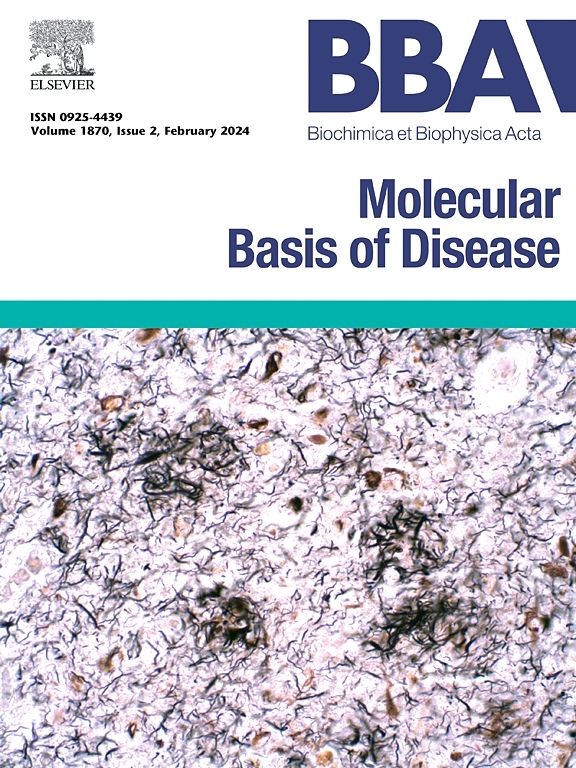连续骨骼肌PGC-1α过表达:衰老大脑中线粒体健康的双刃剑
IF 4.2
2区 生物学
Q2 BIOCHEMISTRY & MOLECULAR BIOLOGY
Biochimica et biophysica acta. Molecular basis of disease
Pub Date : 2025-04-12
DOI:10.1016/j.bbadis.2025.167851
引用次数: 0
摘要
线粒体功能障碍是骨骼肌和大脑与年龄相关的功能衰退的关键因素。过氧化物酶体增殖物激活受体γ辅助激活因子1- α (PGC-1α)在衰老过程中对线粒体的生物发生和功能至关重要。虽然已知幼龄动物骨骼肌特异性过表达PGC-1α可以模拟运动诱导的益处,但其对衰老组织的慢性系统性影响尚不清楚。本研究旨在确定骨骼肌特异性PGC-1α过表达对老年小鼠线粒体健康、氧化应激、炎症和认知功能的终身影响。我们建立了3个实验组:幼龄野生型小鼠(3-4月龄)、老年野生型小鼠(25-27月龄)和骨骼肌特异性PGC-1α过表达老年小鼠(24-27月龄)。在骨骼肌中,衰老导致线粒体生物发生标志物显著降低,包括PGC-1α、FNDC5和mtDNA含量。PGC-1α过表达逆转了这种下降,提高了PGC-1α、SIRT1、LONP1、SDHA、CS、TFAM、eNOS和mtDNA的表达水平,表明线粒体生物发生得以保存。然而,FNDC5和SIRT3被矛盾地抑制,表明潜在的代偿反馈机制。PGC-1α过表达也增强了合成代谢信号,mTOR和S6磷酸化增加,FOXO1表达降低,有利于促进肌肉生长的环境。此外,衰老通过下调MFN1、MFN2、OPA1、FIS1和PINK1来破坏线粒体动力学。虽然PGC-1α过表达不能恢复融合相关蛋白,但它会进一步降低分裂相关蛋白,增强有丝分裂蛋白,这可以通过PINK1磷酸化的增加来证明。相反,在海马中,肌肉特异性PGC-1α过表达加剧了与年龄相关的线粒体生物发生下降。与衰老野生型对照相比,PGC-1α、SIRT1、CS、FNDC5、细胞色素C和TFAM等关键线粒体标志物的表达水平进一步降低。mTOR磷酸化也被显著抑制,而认知相关蛋白(BDNF、VEGF、eNOS)和行为测试中的表现保持不变。重要的是,骨骼肌特异性PGC-1α过表达在骨骼肌和海马中引发了明显的氧化应激和炎症反应。在骨骼肌中,观察到蛋白羰基、i -κB -α、NF-κB、TNF-α、SOD2和NRF2水平升高,并伴有DNA修复酶OGG1的降低。值得注意的是,在海马中也检测到类似的模式,包括蛋白羰基、iNOS、NF-κB、TNF-α、SOD2、GPX1和NRF2的表达增加,同时OGG1水平降低。这些发现提示PGC-1α在骨骼肌中的过度表达可能导致全身氧化应激和炎症。综上所述,骨骼肌特异性PGC-1α过表达保留了线粒体的生物发生,增强了衰老肌肉中的合成代谢信号,但同时诱导了氧化应激和炎症反应,这可能对大脑中的线粒体健康产生不利影响。这些结果强调了骨骼肌PGC-1α在衰老过程中的复杂作用。本文章由计算机程序翻译,如有差异,请以英文原文为准。

Consecutive skeletal muscle PGC-1α overexpression: A double-edged sword for mitochondrial health in the aging brain
Mitochondrial dysfunction is a critical contributor to age-related functional declines in skeletal muscle and brain. Peroxisome proliferator-activated receptor gamma coactivator 1-alpha (PGC-1α) is essential for mitochondrial biogenesis and function during aging. While skeletal muscle-specific overexpression of PGC-1α is known to mimic exercise-induced benefits in young animals, its chronic systemic effects on aging tissues remain unclear. This study aimed to determine the lifelong impact of skeletal muscle-specific PGC-1α overexpression on mitochondrial health, oxidative stress, inflammation, and cognitive function in aged mice.
We established three experimental groups: young wild-type mice (3–4 months old), aged wild-type mice (25–27 months old), and aged mice with skeletal muscle-specific PGC-1α overexpression (24–27 months old). In skeletal muscle, aging led to significant reductions in mitochondrial biogenesis markers, including PGC-1α, FNDC5, and mtDNA content. PGC-1α overexpression reversed this decline, elevating the expression of PGC-1α, SIRT1, LONP1, SDHA, CS, TFAM, eNOS, and mtDNA levels, suggesting preserved mitochondrial biogenesis. However, FNDC5 and SIRT3 were paradoxically suppressed, indicating potential compensatory feedback mechanisms. PGC-1α overexpression also enhanced anabolic signaling, as evidenced by increased phosphorylation of mTOR and S6, and reduced FOXO1 expression, favoring a muscle growth-promoting environment. Moreover, aging impaired mitochondrial dynamics by downregulating MFN1, MFN2, OPA1, FIS1, and PINK1. While PGC-1α overexpression did not restore fusion-related proteins, it further reduced fission-related protein and enhanced mitophagy proteins, as evidenced by increased PINK1 phosphorylation. In contrast, in the hippocampus, muscle-specific PGC-1α overexpression exacerbated age-associated mitochondrial biogenesis decline. Expression levels of key mitochondrial markers, including PGC-1α, SIRT1, CS, FNDC5, Cytochrome C, and TFAM, were further reduced compared to aged wild-type controls. mTOR phosphorylation was also significantly suppressed, whereas cognition-related proteins (BDNF, VEGF, eNOS) and performance in behavioral tests remained unchanged. Importantly, skeletal muscle-specific PGC-1α overexpression triggered pronounced oxidative stress and inflammatory responses in both skeletal muscle and the hippocampus. In skeletal muscle, elevated levels of protein carbonyls, IκB-α, NF-κB, TNF-α, SOD2, and NRF2 were observed, accompanied by a reduction in the DNA repair enzyme OGG1. Notably, similar patterns were detected in the hippocampus, including increased expression of protein carbonyls, iNOS, NF-κB, TNF-α, SOD2, GPX1, and NRF2, alongside decreased OGG1 levels. These findings suggest that the overexpression of PGC-1α in skeletal muscle may have contributed to systemic oxidative stress and inflammation.
In conclusion, skeletal muscle-specific PGC-1α overexpression preserves mitochondrial biogenesis and enhances anabolic signaling in aging muscle but concurrently induces oxidative stress and inflammatory responses, which may adversely affect mitochondrial health in the brain. These results emphasize the complex role of the skeletal muscle PGC-1α during aging.
求助全文
通过发布文献求助,成功后即可免费获取论文全文。
去求助
来源期刊
CiteScore
12.30
自引率
0.00%
发文量
218
审稿时长
32 days
期刊介绍:
BBA Molecular Basis of Disease addresses the biochemistry and molecular genetics of disease processes and models of human disease. This journal covers aspects of aging, cancer, metabolic-, neurological-, and immunological-based disease. Manuscripts focused on using animal models to elucidate biochemical and mechanistic insight in each of these conditions, are particularly encouraged. Manuscripts should emphasize the underlying mechanisms of disease pathways and provide novel contributions to the understanding and/or treatment of these disorders. Highly descriptive and method development submissions may be declined without full review. The submission of uninvited reviews to BBA - Molecular Basis of Disease is strongly discouraged, and any such uninvited review should be accompanied by a coverletter outlining the compelling reasons why the review should be considered.

 求助内容:
求助内容: 应助结果提醒方式:
应助结果提醒方式:


